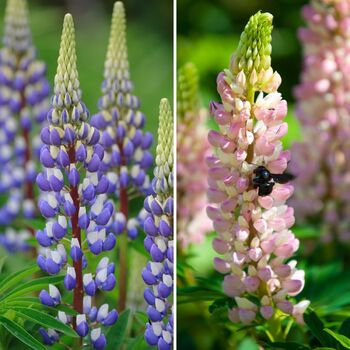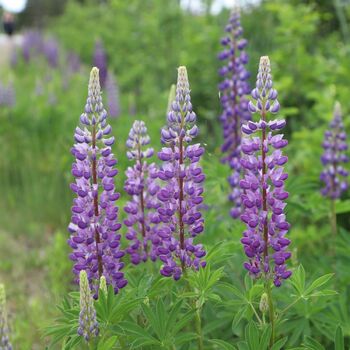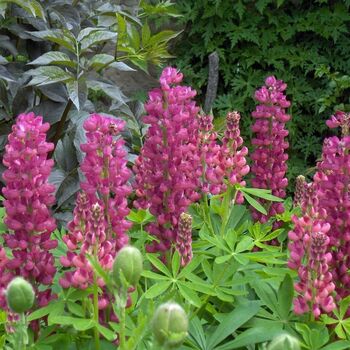
How to Grow Lupin Seeds
Grow Guide #2360
Family: Fabaceae
Binomial name: Lupinus polyphyllus
Life Cycle: Perennial
This 'How to Grow' guide details everything a home gardener needs to know to plant, grow and care for Lupin (Lupinus polyphyllus).
When to Sow Lupin Seeds
Lupin is a perennial plant that grows year round in most climates. Use the table below to identify the best time of year to sow lupin seeds in your climate.
| JAN | FEB | MAR | APR | MAY | JUN | JUL | AUG | SEP | OCT | NOV | DEC | |
|---|---|---|---|---|---|---|---|---|---|---|---|---|
| Cool | ||||||||||||
| Temperate | ||||||||||||
| Sub-Tropical | ||||||||||||
| Tropical | ||||||||||||
| Arid |
Preparation
Lupin plants are best grown in full sun. Choose a location that will receive at least 6 hours of full sun each day.
Lupin plants are short-lived perennials, meaning they usually live for between two and five years. Choose a permanent position where plants can grow undisturbed by regular digging or disturbance.
Lupin plants grow best in soil that is alkaline. If soil pH is under 7, apply dolomite (calcium magnesium carbonate) or garden lime (calcium carbonate) in powder or liquid form at the recommended rate and water in well prior to planting. Lime increases the alkalinity (or pH) of soil, making nutrients more available to some plants. Learn more about preparing soil for planting here.
How to Sow Lupin Seeds
Optional: Soaking seeds prior to planting may improve the speed and success of germination. Soaking seeds in water can help to soften hard seed coats, which can break dormancy and spur the seeds to germinate. Read more about soaking seeds here.
Lupin seeds can be sown directly into the garden OR seedlings can be raised in trays or other containers and transplanted to the garden once established.
Sow Direct
- Sow seeds directly in the garden 15mm deep and 40-60cm apart.
- Keep soil moist but never wet or dry.
- Seeds should germinate in around 15-75 days at a soil temperature of 12-22°C.
- Young seedlings will need protection from pests, pets and weather until they are established.
Raise Seedlings
- Fill trays, punnets or jiffy pots with a good quality seed-raising mix, or use soil starter pellets.
- Sow seeds 15mm deep.
- Keep soil moist but never wet or dry.
- Seeds should germinate in around 15-75 days at a soil temperature of 12-22°C.
- Transplant seedlings to the garden once they have their first true leaves and are large enough to handle (usually 5-10cm tall).
- Plant out, spacing plants 40-60cm apart.
Lupin is a half hardy crop. Mature plants will survive light frosts but seedlings need protection until they are established. Do not transplant seedlings or sow seeds outside until all danger of frost has passed.
Tip: Seeds of this variety can be slow to germinate. Take note of the expected germination time, be patient and follow the recommended depth and temperature guidelines closely for the best chance of success.
How to Grow Lupin
Lupin plants may need watering during the growing season. Water when the soil is dry about 5cm below the surface (test this by scratching away a little soil with your finger). Water deeply in the early morning or late afternoon. Avoid watering the leaves of plants to avoid fungal diseases. Learn more about watering here.
If soil was well prepared no extra fertiliser should be necessary. In poor soil or to give your plants an extra boost, application of a high-potassium fertiliser or one formulated for flowering plants can be beneficial:
- Apply slow release fertiliser at the recommended rate when transplanting or when seedlings are 5-10cm tall.
- Apply liquid fertiliser at the recommended rate and frequency while plants are fruiting or flowering.
Lupin plants may need to be supported as they grow. Depending on the expected size and height of the plant, use a stake, bamboo cane, trellis or string lines to support plants. Make sure you have the support in place when you sow seed or transplant seedlings to avoid disturbing the plant's roots later.
Lupin plants should flower in approximately 200 days.
Deadhead lupin flowers regularly during the growing season. Using sharp secateurs or snips cut fading or dead flowers off just above a set of leaves. Removing old flowers regularly will encourage plants to produce more flowers. Learn more about deadheading flowering plants here.
When plants have finished flowering prune them back to neaten them and encourage strong new growth. Using sharp secateurs or snips, cut individual stems just above a set of lower leaves.
If growing lupin for cut flowers, use sharp snips or secateurs to cut the longest stems possible, removing the lower leaves and placing the stems immediately in a clean bucket of water. Learn more about cutting and conditioning homegrown flowers here.
Lupin plants may die back in cold weather. Cut plants back just above ground level in late autumn, or prune off dead foliage when new leaves emerge in spring.
Common Problems when Growing Lupin
Like all plants, lupin is susceptible to some pests, diseases and other problems. Below is a list of the most common problems gardeners encounter when growing lupin plants:
 Aphids are small (2-4mm long) sap-sucking insects that congregate on the new shoots or the undersides of leaves. They can cause leaves to wilt or become discoloured, and also excrete honeydew which can attract ants and other insect pests. To manage aphids, remove them by spraying with a garden hose, apply a soap or alcohol spray, or encourage predatory insects to your garden. Read more about aphids here.
Aphids are small (2-4mm long) sap-sucking insects that congregate on the new shoots or the undersides of leaves. They can cause leaves to wilt or become discoloured, and also excrete honeydew which can attract ants and other insect pests. To manage aphids, remove them by spraying with a garden hose, apply a soap or alcohol spray, or encourage predatory insects to your garden. Read more about aphids here. Slugs and snails are molluscs that feed on tender leaves and shoots, mostly at night, leaving slimy trails behind them. Control them by removing their hiding places, keeping free range poultry, collecting them by torchlight or by placing traps. Read more about slugs and snails here.
Slugs and snails are molluscs that feed on tender leaves and shoots, mostly at night, leaving slimy trails behind them. Control them by removing their hiding places, keeping free range poultry, collecting them by torchlight or by placing traps. Read more about slugs and snails here.


.png)





